LESSON 6. Communicating with Other LinkedIn Members
In this lesson, you learn about the LinkedIn network and the many ways to communicate with other LinkedIn members.
Understanding Your LinkedIn Network
Before you start communicating with others on LinkedIn, you need to understand how LinkedIn classifies its members in terms of their connections to you. This distinction is important because it determines what, if any, restrictions LinkedIn places on your ability to contact people.
Your LinkedIn network consists of three levels of connections:
• 1st-degree connections: LinkedIn members you connect with directly. Either you sent them an invitation to connect and they accepted, or you accepted their invitations. Your connection list on your profile displays your 1st degree connections. When LinkedIn refers to “your connections,” this means your 1st degree connections.
• 2nd-degree connections: LinkedIn members who connect directly with your 1st degree connections.
• 3rd-degree connections: LinkedIn members who connect directly with your 2nd degree connections.
For example, if you connect directly with your colleague Nicole, she is your 1st degree connection. If Nicole connects directly to Ben, her former classmate, Ben is your 2nd degree connection. If Ben connects directly with Drake, one of his co-workers, Drake is your 3rd degree connection.
LinkedIn also considers fellow members of groups as part of your network. See Lesson 11, “Participating in LinkedIn Groups,” for more information about LinkedIn groups.
Plain English: My Network
Your LinkedIn network (termed My Network) differs from the entire LinkedIn network, which consists of all LinkedIn members. At the time of this printing, the entire LinkedIn network includes more than 85 million members.
Tip: View Your Network Statistics
To view how many people are in each level of your network, select Network Statistics from the Contacts drop-down menu on the global navigation bar.
Understanding InMail, Introductions, and LinkedIn Messages
LinkedIn offers several ways to communicate with other members. The type of communication you can send depends on how you’re connected to these members. Your choices include
• Messages: Messages are the primary form of communication on LinkedIn. You can send messages to your direct connections as well as to the people who belong to the same LinkedIn groups as you do. If you can send a message to someone, the Send Message link appears next to their name on their profile and in search results. See “Sending Messages” later in this lesson for more information. Although you’ll often see the term message used generically to refer to all items in your Inbox, it is a specific type of communication in itself.
• Invitations: An invitation is a request to connect with another LinkedIn member. Refer to Lesson 3, “Adding and Managing Connections,” for more information about sending invitations.
• InMail: An InMail is a private message to or from a LinkedIn member who is not your connection. You can receive InMail free if you indicate that you are open to receiving InMail messages on the Account. In general, sending InMail is a paid LinkedIn feature unless the recipient is a premium member who belongs to the OpenLink Network. See “Sending InMail” later in this lesson for more information.
• Introductions: An introduction provides a way to reach out to the people who are connected to your connections. By requesting an introduction through someone you already know, that person can introduce you to the person you’re trying to reach. You can contact your 1st degree connections to request introductions to members who are 2nd and 3rd degree connections. Members with free accounts can have up to five introductions open at a time. See “Requesting Introductions” later in this lesson for more information.
Understanding Your Contact Options
Before you start communicating with another LinkedIn member, you need to understand your available options for contacting that particular person. When you view member profiles or their summary information from another part of the site, the icons next to a member’s name tell you how you’re connected (see Figure 6.1).
Figure 6.1. The icons next to a member’s name tell you how you’re connected.
![]()
These icons identify 1st, 2nd, and 3rd degree connections; fellow group members; LinkedIn premium account holders, and LinkedIn OpenLink network members.
Note: Some LinkedIn Members Have No Icons
Members who display no icons next to their names are out of your network, don’t share any groups, and aren’t premium account holders.
The links that display to the right of a member’s name let you know what contact options are available. These include
• Send a Message: Send a message to a direct connection or group member.
• Send InMail: Send an InMail to someone who isn’t a direct connection. This option doesn’t appear for members to whom you can send a message because it wouldn’t make sense to pay to contact someone you can communicate with freely. If you click the Send InMail link and don’t have a premium account, LinkedIn prompts you to sign up for one before you can proceed.
• Send InMail (Free): Send an OpenLink message to a member of the OpenLink Network. LinkedIn members who hold premium accounts can offer you the option of sending them free InMail. Refer to Lesson 1, “Introducing LinkedIn,” for more information about the OpenLink Network.
• Recommend This Person: Post a recommendation for this LinkedIn member.
• You Have Recommended This Person: View the recommendation you posted.
• Get Introduced Through a Connection: Request an introduction to this member through a 1st degree connection.
• Add [First Name] to Your Network: Send an invitation to connect. Refer to Lesson 3, “Adding and Managing Connections,” for more information about sending connection requests.
• Forward This Profile to a Connection: Forward a member’s profile to a member you know, as a way of informal introduction.
• Find References: Search for LinkedIn members who worked at the same company at the same time as this member.
• Save [First Name]’s Profile: Save this person’s profile to your Profile Organizer (a premium feature). See Lesson 7, “Searching on LinkedIn,” for more information.
These are the link names that appear on an actual profile. The link names in search results are sometimes abbreviated.
Caution: Not All Options Are Available for All Members
Remember that you’ll never see all these options for any one member. For example, it wouldn’t make sense to send InMail, request an introduction, or add to your network a member who is already your connection, so these options don’t appear for your connections.
Managing Your Inbox
Your Inbox is the focal point for all your direct communication on LinkedIn. A summary of your three most recent Inbox items appears at the top of your home page. You can also click the Inbox link on the global navigation bar to open the Inbox page, shown in Figure 6.2.
Figure 6.2. Your Inbox is the focal point for your personal communications on LinkedIn.
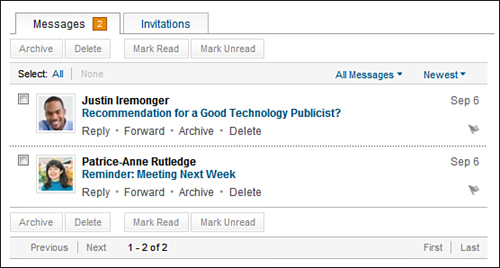
The default view of your Inbox is the Messages tab, which displays all the messages you’ve received. If you have a lot of Inbox messages and want to filter what you see, click the All Messages link and choose one of the available options from the drop-down menu. For example, you can choose to display only unread messages, flagged messages, InMails, recommendations, introductions, profiles, jobs, or blocked messages. By default, LinkedIn displays your messages in order from newest to oldest. To reverse this order, click the Newest link and select Oldest from the drop-down menu.
Tip: Search for Specific Content
In addition to filtering Inbox items, you can also search for a specific message. Enter a keyword in the text box on the left side of the page and click the Search button (the button with the magnifying glass). LinkedIn displays all messages containing that search term. For example, you could search for a person’s name or a word or phrase in the subject line or message text.
From the Messages tab, you can
• View a pop-up box with information about the sender by pausing your mouse over the sender’s name. To view the complete profile, click the sender’s name.
• View a message by clicking its subject line.
• Reply to a message by clicking the Reply link below the message’s subject line. See “Reading and Replying to Messages” later in this lesson for more information.
• Forward a message to another LinkedIn member by clicking the Forward link below the message’s subject line.
• Archive a message by clicking the Archive link below the message’s subject line. This moves your message to the Archived folder, which you can access at any time by clicking the Archived link on the left side of your Inbox. It’s a good idea to archive old or resolved messages to keep your Inbox focused on your current action items.
• Delete a message by clicking the Delete link below the message’s subject line. This removes the message from your Inbox and places it in your Trash folder. You can access the Trash folder by clicking the Trash link on the left side of your Inbox. In this folder, you can choose to empty your trash, undelete a message you deleted by mistake, or delete messages permanently.
Tip: You Can Archive or Delete Multiple Messages
To archive or delete more than one message at a time, select the check box to the left of all the messages you want to move and then click either the Archive or Delete button at the top of the Inbox.
• Mark a message as read or unread. By default, new messages appear in bold text to signify they have not yet been read. After you read a message, the message no longer is boldfaced in your Inbox. To change this, select the check box to the left of a message and click either the Mark Unread button.
• Flag a message as an action item for follow-up. By default, new messages include a flag icon to the right of the subject line, flagging it as an action item. Click the flag icon, which serves as a toggle, to flag or unflag a message for action.
The Inbox also includes another tab: Invitations. This tab displays all open invitations you need to respond to. Refer to Lesson 3 for more information about responding to invitations to connect.
Sending Messages
To send a message to a 1st degree connection or group member, follow these steps:
- On the global navigation bar, select Compose Message from the Inbox drop-down menu. You can also send a message by clicking the Compose Message button from your Inbox.
- In the To field, start typing the name of your connection and wait for LinkedIn to find a match (see Figure 6.3).
Figure 6.3. Sending a direct message to one of your LinkedIn connections.
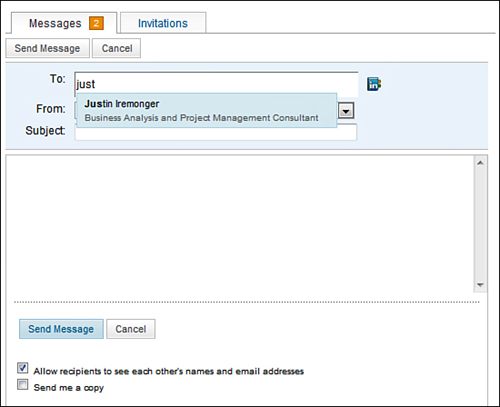
Tip: Send a Message to Multiple Connections
Alternatively, click the address book icon to open your connection list. With the address book, you can search for the person you want to reach or select multiple recipients for your message. LinkedIn allows you to send a message to up to 50 connections at one time.
- Enter a subject for your message.
- Enter your message in the text box.
- If you’re sending a message to multiple recipients and don’t want to disclose this information, remove the check mark before the Allow Recipients to See Each Other’s Names and Email Addresses check box (selected by default).
- To email yourself a copy of your message, select the Send Me a Copy check box. Your message already appears in your Sent folder by default.
- Click the Send Message button. LinkedIn sends your message to the recipient and notifies you that your message was sent.
Although clicking the Compose Message link is the primary way to send messages on LinkedIn, you can also send messages by clicking the Send a Message link in a profile, on your home page, or in search results.
Tip: Other Ways to Contact LinkedIn Members
The profiles of your direct connections also display their external email address in the Contact Information box on the right sidebar. Some members include their email addresses directly on their profiles for the entire LinkedIn network to see.
Reading and Replying to Messages
You can open your messages from the Inbox preview on your home page or from the Inbox itself. (Access it by clicking the Inbox link on the global navigation bar.)
Click the subject line link of any message to open it. Figure 6.4 illustrates a sample message.
Figure 6.4. View a message and reply to it.
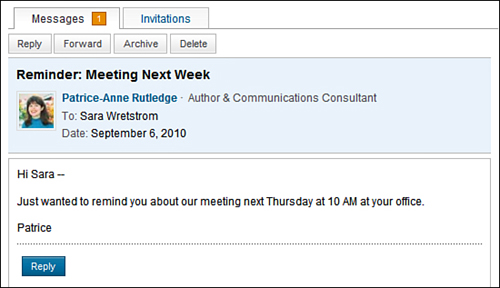
The buttons that appear at the bottom of a message vary depending on the message type and what actions you can take. For example, a basic message includes the Reply button, a recommendation request includes the Write a Recommendation button, and an invitation to connect includes the Accept button and Ignore button.
Sending InMail
As you learned earlier in this lesson, InMail enables you to contact LinkedIn members who aren’t in your network. In an effort to manage spam, LinkedIn requires members to pay to send InMail. InMail is most useful for members who want to contact a wide variety of people, such as recruiters or individuals using LinkedIn for business development.
LinkedIn premium accounts, including Job Seeker premium accounts, enable you to send a fixed number of InMail messages per month. To learn more about LinkedIn premium accounts and InMail, click the Upgrade My Account link on the bottom navigation menu. To learn more about Job Seeker premium accounts, select Job Seeker Premium from the Jobs drop-down menu on the global navigation bar.
You can also purchase individual InMails at $10 each. To do so, go to the global navigation bar, click the down arrow to the left of your name, and select Settings from the drop-down menu. Then, click the Purchase link to the right of the InMails field on the Account & Settings page. This is cost-efficient only if you want to contact just a few people by InMail.
Tip: When You Can Send Free InMail
If you see the word Free immediately following a Send InMail link, you can send InMail to this LinkedIn member at no charge. To enable members to send you free InMail, you must participate in the OpenLink Network, a premium feature.
See Lesson 1 to learn more about the OpenLink Network and premium account options. See Lesson 9, “Finding a Job,” to learn more about Job Seeker premium accounts.
To determine the InMail options available for a particular member, view the contact options on that person’s profile (see Figure 6.5).
Figure 6.5. Determine the InMail options for a particular LinkedIn member.
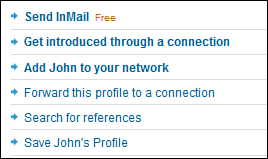
Note: Where Is the Send InMail Link?
You won’t see any Send InMail link for members who indicate on the Account & Settings page that they aren’t open to receiving InMail. InMail isn’t an option for your connections, either. You can contact them directly at no cost to either party.
To send InMail to a LinkedIn member, follow these steps:
- Click the Send InMail link on the profile of the person you want to reach. If you’re sending paid InMail, the Compose Your Message page opens. If you’re sending free InMail, the Compose Your OpenLink Message page opens (see Figure 6.6). These pages contain identical information.
Figure 6.6. Sending free InMail to members of the OpenLink Network.
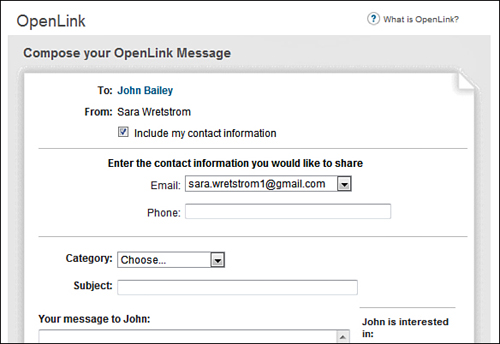
- If you don’t want to share your contact information with the person you want to reach, remove the check mark from the Include My Contact Information check box (selected by default). In general, it’s a good idea to share contact information. To do so, enter your email address and phone number in the specified fields.
- In the Category drop-down list, select the reason for your InMail. Options include career opportunity, consulting offer, new venture, job inquiry, expertise request, business deal, reference request, or get back in touch.
- In the Subject field, enter the subject of your InMail.
- In the text box, enter your message. To increase your chances of a positive reply, be as specific as possible.
- Click the Send button to send your InMail. If the recipient doesn’t respond to the InMail within seven days, the message expires.
For more information about InMail, refer to “Understanding InMail, Introductions, and LinkedIn Messages” earlier in this lesson and also refer to Lesson 1.
Tip: Consider Alternatives to InMail
Although InMail is an effective LinkedIn communication tool, it comes at a price. If you want to contact someone you don’t know and don’t want to pay to send InMail, you have several other options. You could join a group that this person belongs to and then send a message or invitation to connect as a fellow group member. You could also request an introduction through a mutual connection. Alternatively, you could choose to contact the individual outside LinkedIn by accessing the website links and external email information individuals provide on their profiles.
Requesting Introductions
Requesting an introduction is a good way to connect with people in your network whom you don’t connect with directly. Although you can send an invitation to connect to someone you don’t know, you might want to consider requesting an introduction through a shared connection for important communications. An introduction can carry more weight than a cold contact.
For example, let’s say that you’re connected to your former manager Felice (1st degree connection) and Felice is connected to Dalton (2nd degree connection), a manager at another local company. You’re very interested in working in Dalton’s department, but you don’t know him and haven’t seen any posted job openings. Rather than sending Dalton an email and resume as a cold contact, you could send an introduction request through Felice.
Often you’ll know already how you’re connected to the person you want to reach, but you can also determine this by viewing the How You’re Connected To [First Name] section in the right column of your target contact’s profile. If you don’t already know of a common connection, this section could list a name you recognize.
Here are several tips for making the most of LinkedIn introductions:
• Talk to your 1st degree connection before sending an introduction request on LinkedIn. Your connection might have information that’s pertinent to your request. For example, if you’re trying to reach someone about job opportunities, your connection might know if your target is hiring or if there’s a more suitable person to contact.
• Focus on introductions to 2nd degree connections for best results. Although you can request an introduction to a 3rd degree connection, this requires two intermediaries. In many cases, the second intermediary (your 2nd degree connection passing on your request to your 3rd degree connection) might not even know you.
• Make your introduction request concise and specific. A vague request to “get to know” someone isn’t nearly as effective as stating your specific purpose, such as seeking employment, recruiting for a job, offering consulting services, and so forth.
• Keep in mind that you can have only five open introductions at one time with a free LinkedIn basic account. You can find out how many introductions you still have available on the Account & Settings page (go to the global navigation bar, click the down arrow to the left of your name, and select Settings from the drop-down menu). To increase your number of open introductions, you need to upgrade to a premium account. LinkedIn recommends using introductions judiciously rather than as a tool to contact hundreds of members.
To request an introduction, follow these steps:
- Click the Get Introduced Through a Connection link on the profile of the person you want to reach. The Introductions page opens, shown in Figure 6.7.
Figure 6.7. Requesting an introduction to someone your connection knows.
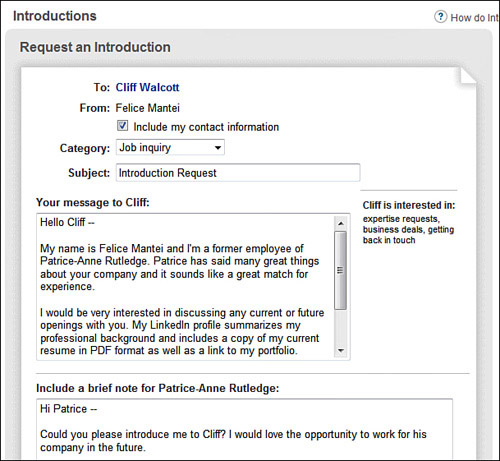
- If you don’t want to share your contact information with the person you want to reach, remove the check mark from the Include My Contact Information check box (selected by default). In general, it’s a good idea to share contact information. To do so, enter your email address and phone number in the specified fields.
- From the Category drop-down list, select the reason for your introduction request. Options include career opportunity, consulting offer, new venture, job inquiry, expertise request, business deal, reference request, or get back in touch.
- In the Subject field, enter the subject of your request.
- In the first text box, enter your message to the person you want to be introduced to.
- In the second text box, enter a brief note to the person you want to make the referral (your 1st degree connection).
- Click the Send button to send your introduction request.
Your 1st degree connection receives your request and can choose to forward it to your target connection with comments or decline your request. If your request wasn’t clear, your connection might ask you for more information.
See the following section, “Managing Introduction Requests,” for more information about the next step in the process.
Managing Introduction Requests
In addition to requesting your own introductions to others, you might also receive introduction requests. For example, LinkedIn members might ask you to facilitate an introduction to one of your connections or might ask your connection to facilitate an introduction to you.
To review and respond to introduction requests, follow these steps:
- On the global navigation bar, click the Inbox link to open your Inbox.
- Click the All Messages link and select Introductions from the drop-down menu. Your Inbox displays only your introduction requests. Alternatively, you can also view new introduction requests in your Inbox preview on your home page or receive them by email. (Specify this on the Account & Settings page.)
- To open the request, click the subject line link. Figure 6.8 illustrates a sample introduction request.
Figure 6.8. Forward an introduction request on to one of your connections.
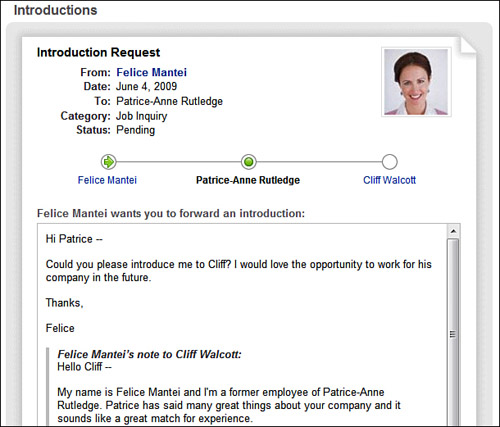
- Click the Forward button to forward the request to your connection.
Note: Declining an Introduction Request
If you don’t want to make the introduction, click the Decline button, select a reason why you feel the introduction isn’t a good fit, and click the Send button. The person who requested the introduction will receive your feedback on why you declined the introduction.
- Enter any additional comments in the text box and click the Forward Message button.
The target recipient receives your forwarded introduction request and can accept or decline it. Accepting the introduction enables the requestor and target to communicate with each other, but they still need to send an invitation request to become connections.
Summary
In this lesson, you learned about the many ways to communicate with other LinkedIn members and the options available based on their connection to you. Next, you learn how to search for people on LinkedIn.
